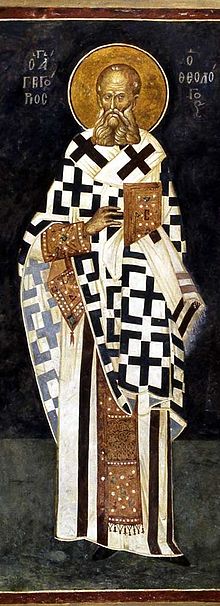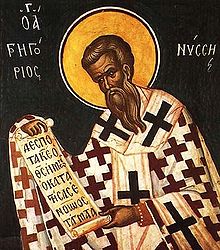Cappadocian Fathers
This article needs additional citations for verification. (August 2007) |


The Cappadocian Fathers (or Cappadocian philosophers) are Basil the Great, bishop of Caesarea, Gregory of Nyssa, bishop of Nyssa, and a close friend, Gregory Nazianzus, Patriarch of Constantinople. They are significant figures in the history of the Church Fathers, who significantly promoted the early Christian theology, and are highly respected in both Western and Eastern churches as Saints. They were a 4th-century monastic family, led by St Makrina to provide a central place for her brothers to study and meditate, and also to provide a peaceful shelter for their mother. Abbess Makrina fostered the education and development of three men who collectively became designated the Cappadocian Fathers: Basil the Great, was the second oldest of Makrina's brothers, the eldest being the famous Christian jurist Naucratius, Gregory of Nyssa, another of Makrina's brothers, and Gregory Nazianzus was a close friend.

These scholars set out to demonstrate that Christians could hold their own in conversations with learned Greek-speaking intellectuals and that Christian faith, while it was against many of the ideas of Plato and Aristotle (and other Greek Philosophers), was an almost scientific and distinctive movement with the healing of the soul of man and his union with God at its center- one best represented by monasticism. They made major contributions to the definition of the Trinity finalized at the First Council of Constantinople in 381 and the final version of the Nicene Creed which was formulated there.
Subsequent to the First Council of Nicea, Arianism did not simply disappear. The semi-Arians taught that the Son is of like substance with the Father (homoiousios) as against the outright Arians who taught that the Son was not like the Father. So the Son was held to be like the Father but not of the same essence as the Father.
The Cappadocians worked to bring these semi-Arians back to the orthodox cause. In their writings they made extensive use of the (now orthodox) formula "three substances (hypostases) in one essence (ousia)," and thus explicitly acknowledged a distinction between the Father and the Son (a distinction that Nicea had been accused of blurring), but at the same time insisting on their essential unity.
Thus Basil wrote:
"In a brief statement, I shall say that essence (ousia) is related to substance (hypostasis) as the general to the particular. Each one of us partakes of existence because he shares in ousia while because of his individual properties he is A or B. So, in the case in question, ousia refers to the general conception, like goodness, god-head, or such notions, while hypostasis is observed in the special properties of fatherhood, sonship, and sanctifying power. If then they speak of persons without hypostasis they are talking nonsense, ex hypothesi; but if they admit that the person exists in real hypostasis, as they do acknowledge, let them so number them as to preserve the principles of the homoousion in the unity of the godhead, and proclaim their reverent acknowledgment of Father, son, and Holy spirit, in the complete and perfect hypostasis of each person so named."
—Epistle 214.4.
Basil thus attempted to do justice to the doctrinal definitions of Nicea while at the same time distinguishing the Nicene position from modalism, which had been Arius's original charge against Pope Alexander in the Nicene controversy. The outcome was that Arianism and semi-Arianism virtually disappeared from the church.
While the Cappadocians shared many traits, each one exhibited particular strengths. Scholars note that Basil was "the man of action", Gregory of Nazianzus "the orator" and Gregory of Nyssa "the thinker".[1]
| Part of a series on |
| Eastern Christianity |
|---|
 |
See also
- Basil of Caesarea
- Gregory Nazianzus
- Gregory of Nyssa
- Peter of Sebaste
- Three Holy Hierarchs: Basil of Caesarea, Gregory of Nazianzus and John Chrysostom.
Notes
- ^ Johannes Quasten (1960): Patrology, Vol. III, pp. 204, 236, 254, as quoted in Børtnes (2006), p. 10
References
- Børtnes, Jostein (2006). Gregory of Nazianzus: Images and Reflections. Copenhagen: Museum Tusculanum Press. ISBN 87-635-0386-7.
{{cite book}}: Unknown parameter|coauthors=ignored (|author=suggested) (help)
